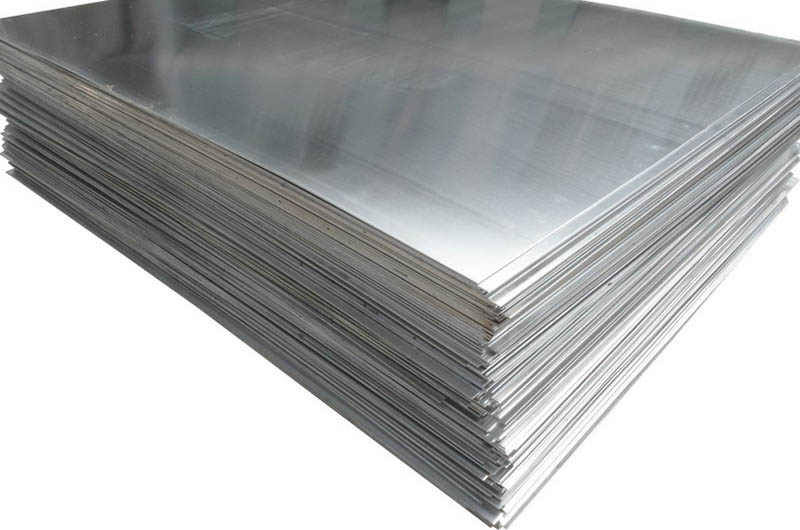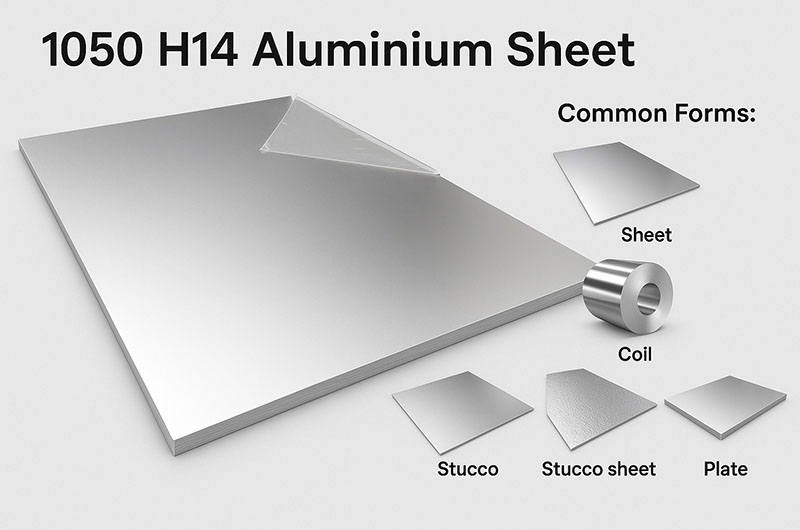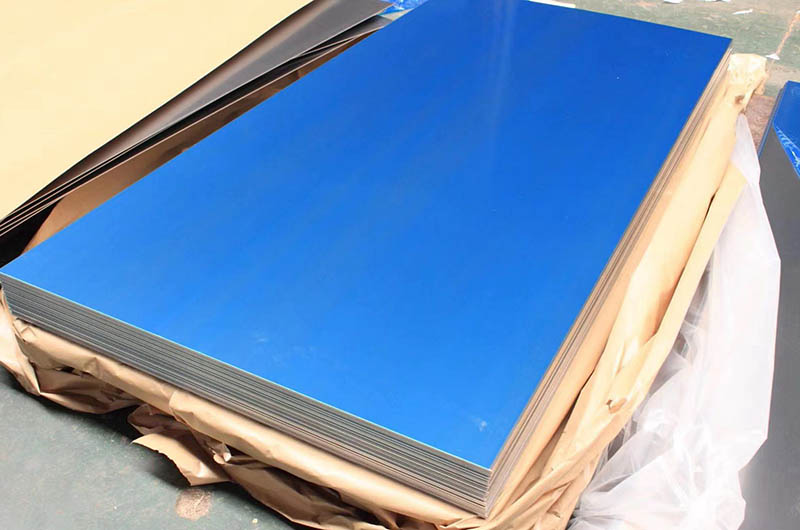1050 h14 aluminium sheet plate
1050 H14 aluminum is a strain-hardened aluminum alloy that belongs to the commercial pure aluminum series, with a purity of 99.5% Al. The 1050 aluminum alloy in the H14 state exhibits higher strength compared to the annealed (O state) but is lower than the fully hard (H18 state). This state is achieved through a simple hardening process, giving the aluminum alloy a balance of strength, good ductility, and excellent machinability.
1050 H14 aluminum is processed to a semi-hard state (H14) through work hardening. This state is achieved by rolling the sheet without subsequent annealing, resulting in a material that strikes a good balance between strength and ductility, while retaining the high formability characteristics of the 1000 series alloys.
H14 indicates a semi-hard temper, processed through cold rolling, offering a combination of strength and plasticity. It is widely used in industries that require lightweight, durable, and corrosion-resistant materials, making it an economical choice for general applications.

1050 H14 Aluminium Sheet generally refers to industrial pure aluminium sheets with a thickness of less than 6mm.
Form: Supplied in sheet, coil, stucco sheet, or plate form, often with protective film or coatings .
1050 H14 Aluminium Product Specifications
- Thickness: 0.5–6.0 mm (common range).
- Sheet size: Up to 4000 x 2000 mm.
- Coating: PVC coating or stucco finish available to enhance durability.
- Certification: Ensures compliance with standards such as BS EN 485-2 or ASTM B491.
- Customization: Some suppliers offer custom sizes and coatings.
- Packaging: Typically packaged in pallets or shrink wrap for protection.
Characteristics of 1050 H14 Aluminum Sheet
- Excellent Machinability: 1050 H14 aluminum sheets are part of the non-heat-treatable aluminum alloy series, strengthened through cold processing, and show exceptional cold working properties. This aluminum alloy demonstrates good cutting, stamping, and forming abilities during processing, making it highly versatile for various manufacturing applications.
- Superior Anodizing Quality: After anodizing, 1050 H14 aluminum displays an impressive appearance with excellent gloss and uniform color. The anodized layer offers high corrosion resistance and reflectivity, making the aluminum sheet ideal for applications requiring a high-quality surface finish.
- High Reflective Finish: The surface finish of 1050 H14 aluminum alloy is high, providing a high-quality effect in reflective applications. For example, its use in lighting reflectors can significantly enhance light reflection efficiency, improving lighting effects.
- Excellent Weldability: 1050 H14 aluminum alloy has outstanding weldability, suitable for various welding methods, including gas welding, arc welding, brazing, and soldering. This characteristic allows the aluminum alloy to achieve strong connections during welding, meeting diverse engineering needs.
- Excellent Ductility: 1050 H14 aluminum alloy has excellent ductility, allowing it to be deeply processed without cracking. It is suitable for various machining processes, ensuring high efficiency and reliability in different industrial applications.
1050 h14 aluminium supplied forms
- 1050 H14 Aluminum Plate: Thick aluminum plates typically used in applications requiring durability and strength, available in various dimensions and thicknesses.
- 1050 H14 Aluminum Sheet: Flat sheets of 1050 H14 aluminum, suitable for a wide range of uses including manufacturing, construction, and industrial applications.
- 1050 H14 Aluminum Sheet with a PVC Coating on One Side: Aluminum sheets with a PVC coating on one side, offering enhanced protection against scratches, corrosion, and environmental damage.
- 1050 Stucco Aluminum Sheet: Aluminum sheets with a stucco pattern that provides a textured surface, often used for decorative purposes and improved impact resistance.
- 1050 Stucco Aluminum Sheet with a PVC Coating on One Side: Stucco-patterned aluminum sheets with a PVC coating on one side, combining the benefits of the textured surface with additional protection from the coating.

1050 H14 Aluminum Sheet Hot Selling Size Table
| Thickness (in) | Width (in) | Length (in) | Notes |
| 0.080" 1050 H14 aluminum sheet | 12" | 24" | Standard sheet size |
| 0.100" 1050 H14 aluminum sheet | 24" | 48" | Standard sheet size |
| 0.125" 1050 H14 aluminum sheet | 48" | 144" | Standard sheet/plate |
| 0.160" 1050 H14 aluminum sheet | 12" | 24" | Standard sheet/plate |
| 0.190" 1050 H14 aluminum sheet | 24" | 48" | Standard sheet/plate |
| 0.250" 1050 H14 aluminum sheet | 48" | 144" | Standard plate |
| 0.313" 1050 H14 aluminum sheet | 12" | 24" | Standard plate |
| 0.375" 1050 H14 aluminum sheet | 24" | 48" | Standard plate |
| 0.500" 1050 H14 aluminum sheet | 24" | 48" | Standard plate |
| 0.625" 1050 H14 aluminum sheet | 12" | 24" | Standard plate |
| 0.750" 1050 H14 aluminum sheet | 24" | 48" | Standard plate |
1050 h14 aluminium alloy designations
Aluminium 1050-H14; UNS A91050; NF A5 (France); DIN Al99.5; AA1050-H14, ASTM B491; BS 1B (UK); CSA 9950 (Canada); ASTM B491; Al1050-H14

1050 h14 aluminium Chemical Composition
| Element | % Present |
| Cu | 0-0.05 |
| Mg | 0-0.05% |
| Si | 0-0.25% |
| Fe | 0-0.4% |
| Mn | 0-0.05% |
| Zn | 0-0.07% |
| Ti | 0-0.05% |
| Al | Balance |
1050 h14 aluminium Mechanical Properties
(for sheet thicknesses from 0.2 mm to 6.00 mm)
| Property | Value |
| Tensile Strength | 105–145 MPa |
| Proof (Yield) Strength | Minimum 85 MPa |
| Elongation | Minimum 12% |
| Hardness | Approximately 34 HB |
Note: These values indicate moderate strength, suitable for general-purpose applications.
1050 h14 aluminium Physical Properties
| Property | Value |
| Density | 2.71 g/cm³ |
| Melting Point | Approximately 650 °C |
| Modulus of Elasticity | About 71 GPa |
| Thermal Conductivity | Around 222 W/m·K |
| Thermal Expansion | 24 × 10⁻⁶ /K |
Note: High thermal conductivity and low density make it suitable for heat transfer and lightweight construction applications.
1050 H14 Aluminium Manufacture and Weldability
- Formability: Excellent cold working properties, suitable for deep drawing, bending, and shaping.
- Weldability: Rated excellent for gas welding, arc welding, and resistance welding; typical filler rods include 1100 for self-welding and 5356 or 4043 for welding other alloys.
- Brazing and Soldering: Also excellent.
- Machinability: Considered poor due to its softness, so forming is typically used instead of machining.
- Cold Working: Excellent formability for bending, rolling, and stamping.
- Welding: Suitable for TIG, MIG, and resistance welding. Recommended filler rods:
- 1100: For welding to similar alloys.
- 5356: For connecting 5xxx or 7xxx series alloys.
- Machining: Poor machinability due to softness; requires sharp tools and lubrication.
1050 H14 Aluminium Advantages and Limitations
1050 H14 Aluminium Advantages
| Advantages | Description |
| High corrosion resistance (ideal for marine/outdoor use) | 1050 H14 aluminum alloy has excellent corrosion resistance, making it perform well in marine and outdoor environments. Its natural aluminum oxide layer effectively resists saltwater and harsh weather conditions, widely used in the marine industry, shipbuilding, and outdoor equipment, ensuring stability and reliability over long-term use. |
| Reflective surface for decorative or functional purposes | The reflective surface characteristics of 1050 H14 aluminum alloy make it highly suitable for applications requiring high gloss and reflective effects. Its surface can reflect a significant amount of light, making it widely used in traffic signs, lighting fixtures, decorative panels, etc., providing both functionality and enhancing visual appeal. |
| Lightweight and durable | 1050 H14 aluminum alloy is lightweight but highly durable. Due to the low density of aluminum and its high strength, 1050 H14 maintains a lightweight while withstanding wear from daily use. It is suitable for applications that require weight control without compromising on durability, such as transportation equipment, structural frames, and electronic product enclosures. |
1050 H14 Aluminium Disadvantages
- Lower strength compared to heat-treatable alloys (e.g., 6082T6).
- Poor machinability, limiting precision applications.
1050 H14 Aluminium Applications
1050 H14 is suitable for various industries due to its reflective surface, weldability, and corrosion resistance:
- Construction: Roofing, cladding, waterproofing sheets, and decorative panels.
- Electrical: Light reflectors, heat exchangers, and conductive components.
- Consumer goods: Kitchenware, signage, and packaging materials.
- Industrial: Chemical equipment containers, heat sinks, signage, cable sheaths, etc.
- Civil applications: Household goods, decorative materials, electronic component enclosures, etc.
1050 H14 aluminum sheet is an economical and versatile material, ideal for applications requiring moderate strength, excellent corrosion resistance, and high formability. Although it is not heat treatable, its performance can be enhanced through cold working. The balance of its performance and cost makes it highly popular across industries, from chemical processing to construction.
1050 H14 aluminum sheet is the preferred material for applications where corrosion resistance, formability, and cost-effectiveness are prioritized. Its balance of mechanical properties and ease of fabrication makes it suitable for construction, industrial, and electrical uses.
Typical Applications of 1050 H14 Aluminum Sheet
- PS Aluminum CTP Printing Plates: In the printing industry, 1050 H14 aluminum alloy is used to produce PS (photosensitive) aluminum plates and CTP (computer-to-plate) printing plates. Its excellent surface finish and high reflective quality ensure superior print quality.
- Aluminum Composite Panels (ACP): 1050 H14 aluminum alloy is used as the outer layer material in aluminum composite panels. Its excellent machinability and corrosion resistance make it suitable for building facade decoration and other applications.
- Battery Soft Connectors: Due to its excellent conductivity and weldability, 1050 H14 aluminum alloy is widely used in battery soft connectors to ensure stable battery performance.
- Signage: The high reflective finish and excellent surface treatment of 1050 H14 aluminum alloy make it an ideal material for producing advertising signage.
- Lighting Reflectors: In the lighting industry, 1050 H14 aluminum alloy is commonly used to manufacture lighting reflectors, enhancing light reflection efficiency and lighting effects.
- Heat Exchangers: This aluminum alloy is used to manufacture heat exchanger components, utilizing its excellent thermal conductivity and corrosion resistance to improve heat dissipation.
- Cable Sheathing: Due to its excellent mechanical properties and corrosion resistance, 1050 H14 aluminum alloy is also used to produce cable sheathing, providing additional protection and durability.
Questions Related to 1050 H14 Aluminum
What is 1050A H14 grade aluminium?
1050A H14 is a specific type of aluminum alloy that combines the characteristics of 1050 aluminum with the H14 temper.
- 1050A: This alloy is a variation of 1050 aluminum, which is a commercially pure aluminum with a minimum of 99.5% aluminum content. The "A" indicates a slight modification in the alloy's composition, which can affect properties such as strength and workability.
- H14: This indicates the temper or hardness of the aluminum. H14 is a strain-hardened condition with a moderate increase in strength compared to the soft, annealed (O) state. The "14" signifies a specific level of hardness and strength in the H temper range.
What is H14 in aluminium?
H14 is a temper designation for aluminum. It refers to a strain-hardened condition where the aluminum has been cold worked to achieve a certain level of hardness and strength, but not as hard as H18 (fully hardened). H14 is used for applications requiring moderate strength and good formability.
What is aluminum 1050 grade?
Aluminum 1050 is a commercially pure aluminum grade with a minimum of 99.5% aluminum content. It is known for its excellent corrosion resistance, high thermal and electrical conductivity, and good workability. However, it has relatively low strength compared to other aluminum alloys.
What is the equivalent of Aluminium 1050?
- EN AW-1050 (European Standard)
- AA 1050 (American Society for Testing and Materials, ASTM)
- JIS A1050 (Japanese Industrial Standard)
Products you may be interested in
- 1050 Aluminum Plate Sheet
- Aluminium 1050 h24
- 1050 H18 Aluminium
- 1050 O Aluminum
- 1050 H112 Aluminum
- 1050 H12 Aluminum
- 1050 H16 Aluminum
- 1050 H22 Aluminum
- 1050 H26 Aluminum
Further reading
Users viewing this material also viewed the following
- 1050 Aluminum Mirror Sheet Coil
- 1050 Embossed Aluminum Sheet
- Hemispherical embossed aluminum sheet coil 1050 1060 1100 for automotive heat shield
- 1050 Color Coated Aluminum Sheet Coil
- 1050 Aluminum Tread Checkered Plate
- 1050 Sublimation Aluminum Sheet
- 1050 H14 Aluminium Circle For Road Sign
- 1050 O Aluminium Strips for Transformers Winding
Recommended Content
